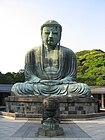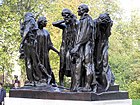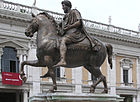«Մասնակից:Makruhi/Ավազարկղ ադ»–ի խմբագրումների տարբերություն
Նոր էջ «https://hy.wikipedia.org/w/index.php?title=%D5%84%D5%A1%D5%BD%D5%B6%D5%A1%D5%AF%D5%AB%D6%81:Makruhi/%D4%B1%D5%BE%D5%A1%D5%A6%D5%A1%D6%80%D5%AF%D5%B2_%D5%A1%D5%A4&action=edit»: |
No edit summary |
||
| Տող 1. | Տող 1. | ||
[[File:Auguste Rodin - Grubleren 2005-02.jpg|thumb|''[[Մտածողը]],''Օգուստ Ռոդեն 1902 թվական]] |
|||
https://hy.wikipedia.org/w/index.php?title=%D5%84%D5%A1%D5%BD%D5%B6%D5%A1%D5%AF%D5%AB%D6%81:Makruhi/%D4%B1%D5%BE%D5%A1%D5%A6%D5%A1%D6%80%D5%AF%D5%B2_%D5%A1%D5%A4&action=edit |
|||
'''Արձանը''' դա մեկ կամ ավելի մարդկանց, կենդանիների ներկայացումն է քանդակագործության միջոցով, բնական չափսերով, կամ կիսանդրիի տեսքով, ավելի հսկայական չափերով, ընդհուպ մինչև այլաբանորեն ներկայացնելը։ <ref>Merriam Webster's Dictionary defines a statue as: "a three-dimensional representation usually of a person, animal, or mythical being that is produced by sculpturing, modeling, or casting" [http://www.merriam-webster.com/dictionary/statue]</ref> Կան նաև շատ փոքր չափի, որոնք հազիվ են տեղավորվում ձեռքի մեջ; Նմանատիպ քանդակները կոչվում են արձանիկներ։ |
|||
Արձանները ստեղծվել են բազմաթիվ ազգային մշակույթներում սկսած նախապատմական շրջանից մինչև մեր օրերը։ Ամենահին հայտնի արձանը ստեղծվել է համարյա 30,000 տարի առաջ։ Աշխարհի ամենաերկար արձանի բարձրությունը հասնում է 500 ոտնաչափի։ |
|||
Բազմաթիվ արձաններ ստեղծվել են հավերժացնելու այս կամ այն պատմական իրադարձություն, ոմանք էլ՝ հայտնի և ազդեցիկ մարդկանց հիշատակը։ կան բազմաթիվ քանդակներ, որոնք ստեղծվել են որպես հասարակական արվեստի գործ բացօդյա ցուցադրությունների կամ հասարակական կառույցներում ցուցադրելու համար։ Որոշ արձաններ հայտնի դառնալու իրավունքն են ձեռք բերել, անկախ որևէ մեկին կամ որևէ սկղբունք ներկայացնելու, որոնց թվում դասվում է Ազատության արձանը։ |
|||
==Գույն== |
|||
Հին աշխարհից պահպանված բազմաթիվ արձանները պարզորեն երևում են թե ինչից են պատրաստված։ Հին հունական արձանները քանդակված էին մարմարից,, սակայն կա ապացույց, որ նրանցից ոմանք ներկում էինն պայծառ գույներով։ <ref name=colorgods>{{cite web|url=http://www.archaeology.org/0801/trenches/colorgods.html |title=Archeological Institute of America: Carved in Living Color |publisher=Archaeology.org |date=23 June 2008 |accessdate=30 December 2012}}</ref> Գույներից ոմանք գունաթափվում էին ժամանակի ընթացքում, ոմանք արձանները մաքրելու ժամանակ, սակայն բոլոր դեպքերում էլ մնում էին հետքեր, որոնցով կարելի էր բնորոշել նրանց նախկին գույնը։<ref name=colorgods/> A travelling exhibition of 20 coloured replicas of Greek and Roman works, alongside 35 original statues and reliefs, was held in Europe and the United States in 2008: Gods in Color: Painted Sculpture of Classical Antiquity.<ref name="artmuseums.harvard.edu">{{cite web|url=http://web.archive.org/web/20090104060402/http://www.artmuseums.harvard.edu/exhibitions/sackler/godsInColor.html |title=Gods in Color: Painted Sculpture of Classical Antiquity September 22, 2007 Through January 20, 2008, The Arthur M. Sackler Museum |publisher=Web.archive.org |date=4 January 2009 |accessdate=30 December 2012}}</ref> Details such as whether the paint was applied in one or two coats, how finely the pigments were ground, or exactly which binding medium would have been used in each case—all elements that would affect the appearance of a finished piece—are not known. Richter goes so far as to say of classical Greek sculpture, "`All stone sculpture, whether limestone ir marble, was painted, either wholly or in part." <ref>Richter, Gosela M. A., ‘’The Handbook of Greek Art: Architecture, Sculpture, Gems, Coins, Jewellery, Metalwork, Pottery and Vase Painting, Glass, Furniture, Textiles, Paintings and Mosaics’’, Phaidon Publishers Inc., New York, 1960 p. 46</ref> |
|||
Medieval statues were also usually painted, with some still retaining their original pigments. The colouring of statues ceased during the Renaissance, as excavated classical sculptures, which had lost their colouring, became regarded as the best models. |
|||
==Historical periods== |
|||
{{main|Sculpture}} |
|||
===Antiquity=== |
|||
[[File:Moai Rano raraku.jpg|thumb|[[Easter Island]] [[moai]] statues]] |
|||
The [[Lion man of the Hohlenstein Stadel|Lion man]] from the [[Swabian Alps]] in Germany is the oldest known statue in the world, and dates to 30,000-40,000 years ago.<ref>"Lion man takes pride of place as oldest statue" by Rex Dalton, ''Nature'' 425, 7 (4 September 2003) doi:10.1038/425007a also [http://www.nature.com/news/2003/030904/full/news030901-6.html Nature News 4 September 2003]</ref><ref>"Ice Age Lion Man is world’s earliest figurative sculpture" by Martin Bailey, [http://www.theartnewspaper.com/articles/Ice-Age-iLion-Mani-is-worlds-earliest-figurative-sculpture/28595 The Art Newspaper 31 January 2013]</ref><ref>[http://www.mus.cam.ac.uk/~ic108/lithoacoustics/BAR2002/BARpreprint.pdf Musical behaviours and the archaeological record: a preliminary study, University of Cambridge]</ref> The [[Venus of Hohle Fels]], from the same area, is somewhat later.<ref>''Painted Caves: Palaeolithic Rock Art in Western Europe'' by Andrew J. Lawson (13 July 2012) ISBN 0199698228 Oxford UP page 125</ref> Throughout history, statues have been associated with [[cult image]]s in many religious traditions, from [[Ancient Egypt]], [[Ancient Greece]], and [[Ancient Rome]] to the present. |
|||
Egyptian statues showing kings as [[sphinx]]es have existed since the [[Old Kingdom of Egypt|Old Kingdom]], the oldest being for [[Djedefre]] (c. 2500 BC).<ref>''The Egyptian Museum in Cairo'' by Abeer El-Shahawy and Farid Atiya (10 November 2005) ISBN 9771721836 page 117</ref> The oldest statue of a striding pharaoh dates from the reign of [[Senwosret I]] (c. 1950 BC) and is the Egyptian Museum, Cairo.<ref>'' The Oxford Encyclopedia of Ancient Egypt'' by Donald B. Redford (15 December 2000) ISBN 0195102347 page 230</ref> The [[Middle Kingdom of Egypt]] (starting around 2000 BC) witnessed the growth of [[block statue]]s which then became the most popular form until the [[Ptolemaic Kingdom|Ptolemaic period]] (c. 300 BC).<ref>''Egyptian Statues'' by Gay Robins (4 March 2008) ISBN 0747805202 page 28</ref> |
|||
The oldest statue of a [[deity]] in Rome was the bronze statue of [[Ceres (mythology)|Ceres]] in 485 BC.<ref>''Famous Firsts in the Ancient Greek and Roman World'' by David Matz (Jun 2000) ISBN 0786405996 page 87</ref><ref>''The Art of Rome c.753 B.C.-A.D. 337'' by Jerome Jordan Pollitt (30 June 1983) ISBN 052127365X page 19</ref> The oldest statue in Rome is now the statue of [[Diana (mythology)|Diana]] on the [[Aventine Hill|Aventine]].<ref>''Samnium and the Samnites'' by E. T. Salmon (2 September 1967) ISBN 0521061857 page 181</ref> |
|||
The [[wonders of the world]] include several statues from antiquity, with the [[Colossus of Rhodes]] and the [[Statue of Zeus at Olympia]] among the [[Seven Wonders of the Ancient World]]. |
|||
===Middle Ages=== |
|||
{{Expand section|date=April 2013}} |
|||
While [[Byzantine art]] flourished in various forms, sculpture and statue making witnessed a general decline; although statues of emperors continued to appear.<ref name=Byz>''Byzantine Art'' by Charles Bayet (1 October 2009) ISBN 1844846202 page 54</ref> An example was the statue of [[Justinian]] (6th century) which stood in the square across from the [[Hagia Sophia]] until the [[fall of Constantinople]] in the 15th century.<ref name=Byz/> Part of the decline in statue making in the Byzantine period can be attributed to the mistrust the Church placed in the art form, given that it viewed sculpture in general as a method for making and worshiping idols.<ref name=Byz/> While making statues was not subject to a general ban, it was hardly encouraged in this period.<ref name=Byz/> Justinian was one of the last Emperors to have a full-size statue made, and secular statues of any size became virtually non-existent after iconoclasm; and the artistic skill for making statues was lost in the process. |
|||
===Modern Era=== |
|||
{{Contradict-other|section|Equestrian statue}} |
|||
Starting with the work of [[Maillol]] around 1900, the human figures embodied in statues began to move away from the various schools of realism that had held them bound for thousands of years. The [[Futurist]] and [[Cubist]] schools took this metamorphism even further until statues, often still nominally representing humans, had lost all but the most rudimentary relationship to the human firm. By the 1920s and 1930s statues began to appear that were completely abstract in design and execution.<ref>Giedion-Welcker, Carola, ‘’Contemporary Sculpture: An Evolution in Volume and Space, A revised and Enlarged Edition’’, Faber and Faber, London, 1961 pp. X to XX</ref> |
|||
The [[urban legend|notion]] that the position of the hooves of horses in [[equestrian statue]]s indicated the rider's cause of death has been disproved.<ref>{{cite web |url=http://www.snopes.com/military/statue.htm|title=Statue of Limitations |author=Barbara Mikkelson |date=2 August 2007 |work= |publisher=Snopes.com |accessdate=9 June 2011}}</ref><ref>{{cite web |url=http://www.straightdope.com/classics/a5_074.html |title=In statues, does the number of feet the horse has off the ground indicate the fate of the rider? |author=Cecil Adams |date=6 October 1989 |work=The Straight Dope |publisher=''Chicago Reader'' |accessdate=9 June 2011}}</ref> |
|||
==Gallery== |
|||
<gallery widths="140px" heights="140px" perrow="4"> |
|||
File:Lion man photo.jpg|[[Lion man]], from [[Hohlenstein-Stadel]], [[Germany]], now in Ulmer Museum, [[Ulm]], [[Germany]], the oldest known [[zoomorphic]] statuette, [[Aurignacian]] era, 40,000 BC-30,000 BC |
|||
File:Venus of Dolni Vestonice.png|[[Venus of Dolní Věstonice]], [[ceramic]] [[figurine]], 29,000 BC-25,000 BC |
|||
File:Venus von Willendorf 01.jpg|[[Venus of Willendorf]], one of the oldest known Statuettes, [[Upper Paleolithic]], 24,000 BC-22,000 BC |
|||
File:Great Sphinx of Giza - 20080716a.jpg|[[Great Sphinx of Giza]], c. 2558–2532 BC, the largest [[monolith]] statue in the world, standing {{Convert|73.5|m|ft|0}} long, {{Convert|6|m|ft|0}} wide, and {{Convert|20.22|m|ft|2|abbr=on}} high. [[Giza]], [[Egypt]]. |
|||
File:AurigaDelfi.jpg|The [[Charioteer of Delphi]], 474 BC, [[Delphi Archaeological Museum]], Greece |
|||
File:Hermes di Prassitele, at Olimpia, front.jpg|[[Hermes and the Infant Dionysus]] by [[Praxiteles]], 4th century BC, [[Archaeological Museum of Olympia]], Greece |
|||
File:Venus de Milo Louvre Ma399 n4.jpg|[[Venus de Milo]], c. 130 - 100 BC, [[Culture of Greece|Greek]], the [[Louvre]] |
|||
File:Laocoon Pio-Clementino Inv1059-1064-1067.jpg|''[[Laocoön and his Sons]],'' Greek, (Late [[Hellenistic art|Hellenistic]]), c. 160 BC and 20 BC, [[White marble]], [[Vatican Museum]] |
|||
File:NaraTodaijiDaibutsu0212.jpg|[[Tōdai-ji|Nara Daibutsu]], c. 752, [[Nara, Nara|Nara]], [[Japan]] |
|||
File:AhuTongariki.JPG|''[[Moai]] of [[Easter Island]] facing inland,'' [[Ahu Tongariki]], c. 1250 - 1500, restored by Chilean archaeologist Claudio Cristino in the 1990s |
|||
File:Kamakura Budda Daibutsu front 1885.jpg|[[Kōtoku-in|The Great Buddha of Kamakura]], c. 1252, [[Kamakura, Japan|Japan]] |
|||
File:David von Michelangelo.jpg|[[Michelangelo's David|Michelangelo's ''David'']], 1504, [[Accademia di Belle Arti Firenze#The Accademi Gallery|The Accademia Gallery]], [[Florence, Italy]] |
|||
File:The.burg.of.calais.london.arp.750pix.jpg|[[Auguste Rodin]], ''[[The Burghers of Calais]]'' (1884–c. 1889) in [[Victoria Tower Gardens]], [[London, England]]. |
|||
File:Statue of Liberty April 2008.JPG|''[[The Statue of Liberty]],'' [[New York]] [[Harbor]], [[USA]], c.1886 |
|||
File:Robert Burns, Union Terrace, Aberdeen, 1892 Henry Bain Smith, bronze, photo Jane Cartney 2010.jpg|Henry Bain Smith's bronze of [[Robert Burns]], 1892, above [[Union Terrace Gardens]], [[Aberdeen]], [[Scotland]] |
|||
File:Copenhagen - the little mermaid statue - 2013.jpg|The [[The Little Mermaid (statue)|Mermaid of Copenhagen]], 1903 |
|||
File:DSC7989.png|statue of Dr. [[Jose Rizal]]. at the [[Rizal Park|Luneta Park]], [[Philippines]] c.1908 |
|||
File:Millais statue 3.jpg|[[Thomas Brock]], ''[[John Everett Millais]],'' at [[Tate Britain]] 1905 |
|||
File:Cristo Redentor - Rio de Janeiro, Brasil.jpg|''[[Christ the Redeemer (statue)|Christ the Redeemer]],'' [[Rio de Janeiro]], [[Brazil]], 1931 |
|||
File:USMC War Memorial Sunset Parade 2008-07-08.jpg|[[USMC War Memorial|U.S. Marine Corps War Memorial]], located in [[Arlington, Virginia|Arlington]], [[Virginia]], 1954 |
|||
File:marcus.aurelius.horse.statue.rome.arp.jpg|A closeup of the replica statue of [[Roman Emperor]], [[Marcus Aurelius]], 1981, The original c. 200 AD is in the nearby [[Capitoline Museum]], [[Rome]] |
|||
File:Ushiku daibutsu.jpg|The [[Ushiku Daibutsu]], [[Amitabha Buddha]], 1993, [[Japan]]. The third tallest statue in the world, overall 394 feet in height. |
|||
File:Spring Temple Buddha picturing Vairocana, in Lushan County, Henan, China.png|[[Spring Temple Buddha]], the world's tallest statue, overall 502 feet in height, completed 2002, [[China]]. |
|||
File:Kailashnath_Mahadev_Statue.jpg|[[Kailashnath Mahadev Statue]], [[Bhaktapur]], [[Nepal]]. The world's tallest Statue of Lord Shiva, 143 feet, 2003-Present. |
|||
</gallery> |
|||
== See also == |
|||
{{col-begin}}{{col-break}} |
|||
* [[Bronze sculpture]] |
|||
* [[Bust (sculpture)]] |
|||
* [[Equestrian sculpture]] |
|||
* [[Figurine]] |
|||
* [[History of sculpture]] |
|||
* [[List of statues]] |
|||
* [[List of statues by height]] |
|||
* [[List of statues of Queen Victoria]] |
|||
{{col-break}} |
|||
* [[Living statue]] |
|||
* [[Memorial]] |
|||
* [[Monument]] |
|||
* [[Sculpture]] |
|||
* [[Statues of Gudea]], c. 2100 BC |
|||
* [[Stone carving]] |
|||
* [[Stone sculpture]] |
|||
* [[The Thinker]] |
|||
* [[Venus of Willendorf]] |
|||
{{col-end}} |
|||
==References== |
|||
{{Reflist|2}} |
|||
==External links== |
|||
{{Commons category|Statues}} |
|||
* [http://pmsa.cch.kcl.ac.uk/index.htm UK Public Monument and Sculpture Association] |
|||
* [http://statues.com/mrc/index.php?option=com_content&view=article&id=92&Itemid=92 Casting Methods & Statue Materials ] |
|||
[[Category:Types of sculpture]] |
|||
08:19, 23 Հուլիսի 2014-ի տարբերակ

Արձանը դա մեկ կամ ավելի մարդկանց, կենդանիների ներկայացումն է քանդակագործության միջոցով, բնական չափսերով, կամ կիսանդրիի տեսքով, ավելի հսկայական չափերով, ընդհուպ մինչև այլաբանորեն ներկայացնելը։ [1] Կան նաև շատ փոքր չափի, որոնք հազիվ են տեղավորվում ձեռքի մեջ; Նմանատիպ քանդակները կոչվում են արձանիկներ։
Արձանները ստեղծվել են բազմաթիվ ազգային մշակույթներում սկսած նախապատմական շրջանից մինչև մեր օրերը։ Ամենահին հայտնի արձանը ստեղծվել է համարյա 30,000 տարի առաջ։ Աշխարհի ամենաերկար արձանի բարձրությունը հասնում է 500 ոտնաչափի։
Բազմաթիվ արձաններ ստեղծվել են հավերժացնելու այս կամ այն պատմական իրադարձություն, ոմանք էլ՝ հայտնի և ազդեցիկ մարդկանց հիշատակը։ կան բազմաթիվ քանդակներ, որոնք ստեղծվել են որպես հասարակական արվեստի գործ բացօդյա ցուցադրությունների կամ հասարակական կառույցներում ցուցադրելու համար։ Որոշ արձաններ հայտնի դառնալու իրավունքն են ձեռք բերել, անկախ որևէ մեկին կամ որևէ սկղբունք ներկայացնելու, որոնց թվում դասվում է Ազատության արձանը։
Գույն
Հին աշխարհից պահպանված բազմաթիվ արձանները պարզորեն երևում են թե ինչից են պատրաստված։ Հին հունական արձանները քանդակված էին մարմարից,, սակայն կա ապացույց, որ նրանցից ոմանք ներկում էինն պայծառ գույներով։ [2] Գույներից ոմանք գունաթափվում էին ժամանակի ընթացքում, ոմանք արձանները մաքրելու ժամանակ, սակայն բոլոր դեպքերում էլ մնում էին հետքեր, որոնցով կարելի էր բնորոշել նրանց նախկին գույնը։[2] A travelling exhibition of 20 coloured replicas of Greek and Roman works, alongside 35 original statues and reliefs, was held in Europe and the United States in 2008: Gods in Color: Painted Sculpture of Classical Antiquity.[3] Details such as whether the paint was applied in one or two coats, how finely the pigments were ground, or exactly which binding medium would have been used in each case—all elements that would affect the appearance of a finished piece—are not known. Richter goes so far as to say of classical Greek sculpture, "`All stone sculpture, whether limestone ir marble, was painted, either wholly or in part." [4]
Medieval statues were also usually painted, with some still retaining their original pigments. The colouring of statues ceased during the Renaissance, as excavated classical sculptures, which had lost their colouring, became regarded as the best models.
Historical periods
Antiquity

The Lion man from the Swabian Alps in Germany is the oldest known statue in the world, and dates to 30,000-40,000 years ago.[5][6][7] The Venus of Hohle Fels, from the same area, is somewhat later.[8] Throughout history, statues have been associated with cult images in many religious traditions, from Ancient Egypt, Ancient Greece, and Ancient Rome to the present.
Egyptian statues showing kings as sphinxes have existed since the Old Kingdom, the oldest being for Djedefre (c. 2500 BC).[9] The oldest statue of a striding pharaoh dates from the reign of Senwosret I (c. 1950 BC) and is the Egyptian Museum, Cairo.[10] The Middle Kingdom of Egypt (starting around 2000 BC) witnessed the growth of block statues which then became the most popular form until the Ptolemaic period (c. 300 BC).[11]
The oldest statue of a deity in Rome was the bronze statue of Ceres in 485 BC.[12][13] The oldest statue in Rome is now the statue of Diana on the Aventine.[14]
The wonders of the world include several statues from antiquity, with the Colossus of Rhodes and the Statue of Zeus at Olympia among the Seven Wonders of the Ancient World.
Middle Ages
While Byzantine art flourished in various forms, sculpture and statue making witnessed a general decline; although statues of emperors continued to appear.[15] An example was the statue of Justinian (6th century) which stood in the square across from the Hagia Sophia until the fall of Constantinople in the 15th century.[15] Part of the decline in statue making in the Byzantine period can be attributed to the mistrust the Church placed in the art form, given that it viewed sculpture in general as a method for making and worshiping idols.[15] While making statues was not subject to a general ban, it was hardly encouraged in this period.[15] Justinian was one of the last Emperors to have a full-size statue made, and secular statues of any size became virtually non-existent after iconoclasm; and the artistic skill for making statues was lost in the process.
Modern Era
Կաղապար:Contradict-other Starting with the work of Maillol around 1900, the human figures embodied in statues began to move away from the various schools of realism that had held them bound for thousands of years. The Futurist and Cubist schools took this metamorphism even further until statues, often still nominally representing humans, had lost all but the most rudimentary relationship to the human firm. By the 1920s and 1930s statues began to appear that were completely abstract in design and execution.[16]
The notion that the position of the hooves of horses in equestrian statues indicated the rider's cause of death has been disproved.[17][18]
Gallery
-
Lion man, from Hohlenstein-Stadel, Germany, now in Ulmer Museum, Ulm, Germany, the oldest known zoomorphic statuette, Aurignacian era, 40,000 BC-30,000 BC
-
Venus of Willendorf, one of the oldest known Statuettes, Upper Paleolithic, 24,000 BC-22,000 BC
-
Great Sphinx of Giza, c. 2558–2532 BC, the largest monolith statue in the world, standing 73.5 metres (241 ft) long, 6 metres (20 ft) wide, and 20.22 m (66.34 ft) high. Giza, Egypt.
-
The Charioteer of Delphi, 474 BC, Delphi Archaeological Museum, Greece
-
Hermes and the Infant Dionysus by Praxiteles, 4th century BC, Archaeological Museum of Olympia, Greece
-
Moai of Easter Island facing inland, Ahu Tongariki, c. 1250 - 1500, restored by Chilean archaeologist Claudio Cristino in the 1990s
-
The Great Buddha of Kamakura, c. 1252, Japan
-
The Mermaid of Copenhagen, 1903
-
A closeup of the replica statue of Roman Emperor, Marcus Aurelius, 1981, The original c. 200 AD is in the nearby Capitoline Museum, Rome
-
The Ushiku Daibutsu, Amitabha Buddha, 1993, Japan. The third tallest statue in the world, overall 394 feet in height.
-
Spring Temple Buddha, the world's tallest statue, overall 502 feet in height, completed 2002, China.
-
Kailashnath Mahadev Statue, Bhaktapur, Nepal. The world's tallest Statue of Lord Shiva, 143 feet, 2003-Present.
See also
References
- ↑ Merriam Webster's Dictionary defines a statue as: "a three-dimensional representation usually of a person, animal, or mythical being that is produced by sculpturing, modeling, or casting" [1]
- ↑ 2,0 2,1 «Archeological Institute of America: Carved in Living Color». Archaeology.org. 23 June 2008. Վերցված է 30 December 2012-ին.
- ↑ «Gods in Color: Painted Sculpture of Classical Antiquity September 22, 2007 Through January 20, 2008, The Arthur M. Sackler Museum». Web.archive.org. 4 January 2009. Վերցված է 30 December 2012-ին.
- ↑ Richter, Gosela M. A., ‘’The Handbook of Greek Art: Architecture, Sculpture, Gems, Coins, Jewellery, Metalwork, Pottery and Vase Painting, Glass, Furniture, Textiles, Paintings and Mosaics’’, Phaidon Publishers Inc., New York, 1960 p. 46
- ↑ "Lion man takes pride of place as oldest statue" by Rex Dalton, Nature 425, 7 (4 September 2003) doi:10.1038/425007a also Nature News 4 September 2003
- ↑ "Ice Age Lion Man is world’s earliest figurative sculpture" by Martin Bailey, The Art Newspaper 31 January 2013
- ↑ Musical behaviours and the archaeological record: a preliminary study, University of Cambridge
- ↑ Painted Caves: Palaeolithic Rock Art in Western Europe by Andrew J. Lawson (13 July 2012) ISBN 0199698228 Oxford UP page 125
- ↑ The Egyptian Museum in Cairo by Abeer El-Shahawy and Farid Atiya (10 November 2005) ISBN 9771721836 page 117
- ↑ The Oxford Encyclopedia of Ancient Egypt by Donald B. Redford (15 December 2000) ISBN 0195102347 page 230
- ↑ Egyptian Statues by Gay Robins (4 March 2008) ISBN 0747805202 page 28
- ↑ Famous Firsts in the Ancient Greek and Roman World by David Matz (Jun 2000) ISBN 0786405996 page 87
- ↑ The Art of Rome c.753 B.C.-A.D. 337 by Jerome Jordan Pollitt (30 June 1983) ISBN 052127365X page 19
- ↑ Samnium and the Samnites by E. T. Salmon (2 September 1967) ISBN 0521061857 page 181
- ↑ 15,0 15,1 15,2 15,3 Byzantine Art by Charles Bayet (1 October 2009) ISBN 1844846202 page 54
- ↑ Giedion-Welcker, Carola, ‘’Contemporary Sculpture: An Evolution in Volume and Space, A revised and Enlarged Edition’’, Faber and Faber, London, 1961 pp. X to XX
- ↑ Barbara Mikkelson (2 August 2007). «Statue of Limitations». Snopes.com. Վերցված է 9 June 2011-ին.
- ↑ Cecil Adams (6 October 1989). «In statues, does the number of feet the horse has off the ground indicate the fate of the rider?». The Straight Dope. Chicago Reader. Վերցված է 9 June 2011-ին.
{{cite web}}: Italic or bold markup not allowed in:|publisher=(օգնություն)
External links
| Վիքիպահեստ նախագծում կարող եք այս նյութի վերաբերյալ հավելյալ պատկերազարդում գտնել Makruhi/Ավազարկղ ադ կատեգորիայում։ |





















